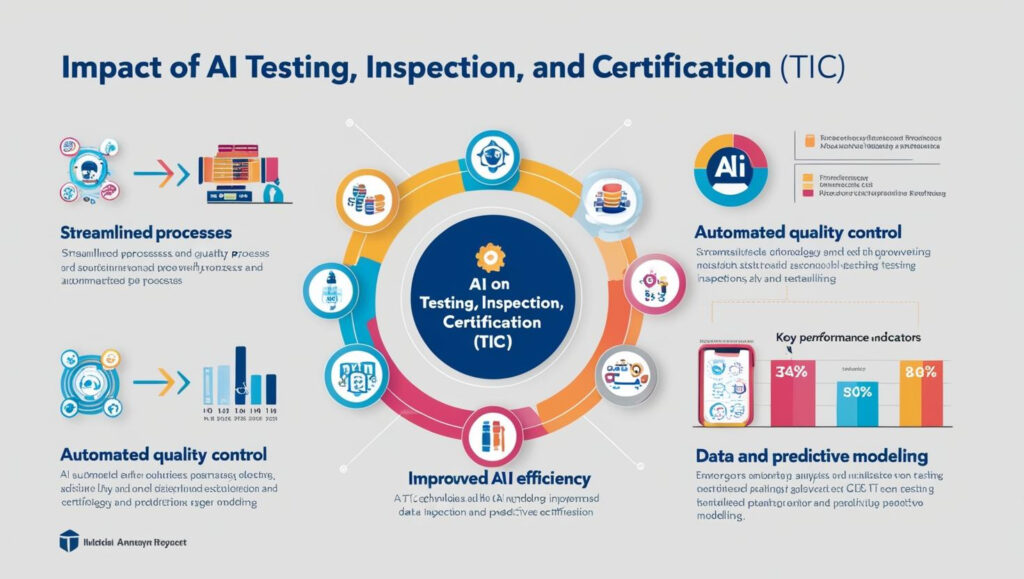The Testing, Inspection, and Certification (TIC) industry, once grounded in traditional, labor-intensive methods, is undergoing a remarkable transformation. Artificial Intelligence (AI) is emerging as a powerful catalyst, reshaping how quality, safety, and compliance are ensured across industries. By automating tasks, enhancing accuracy, and delivering faster insights, AI is revolutionizing the very foundation of TIC services.
Accelerating Inspections with AI
One of the most immediate impacts of AI is the automation of inspection processes. Drones and robots, powered by AI-based computer vision, are now capable of performing complex inspections of infrastructure, manufacturing plants, and critical assets. These smart systems can detect minute defects, cracks, and inconsistencies with greater accuracy and at a fraction of the time it would take human inspectors.
Remote inspections, enabled by AI, are also reducing the need for physical presence, making testing safer, faster, and more cost-effective—especially in hazardous environments like oil rigs or chemical plants.

Download PDF Brochure @ https://www.marketsandmarkets.com/pdfdownloadNew.asp?id=5352498
Enabling Predictive Testing and Maintenance
Instead of relying on scheduled inspections alone, AI allows TIC providers to adopt predictive testing approaches. By analyzing historical and real-time data, AI algorithms can forecast potential failures, enabling companies to act before issues escalate. Predictive maintenance strategies not only enhance operational reliability but also significantly cut down maintenance costs and downtime.
Streamlining Certification and Compliance
AI is simplifying the complex world of certification and compliance management. Machine learning algorithms can automatically review documentation, cross-reference standards, and identify compliance gaps faster than traditional manual reviews. This leads to quicker certification cycles and more consistent adherence to international and industry-specific regulations.
Furthermore, AI-driven audit tools can monitor compliance in real time, providing continuous assurance rather than periodic checks, which dramatically raises the bar for accountability.
Advanced Data Analytics for Smarter Decisions
TIC organizations generate and manage vast amounts of data—from test results to inspection reports. AI tools excel at processing this big data, uncovering hidden patterns and providing actionable insights. With AI-driven analytics, organizations can better understand risks, improve quality control processes, and even develop new services tailored to emerging market needs.
Enhancing Safety and Reducing Human Error
AI-driven automation minimizes the risk of human error in testing and inspection activities. Systems can identify inconsistencies and anomalies with far greater consistency, enhancing the reliability of results. Moreover, by taking over dangerous inspection tasks, AI protects human workers from hazardous situations, contributing to improved occupational safety standards.
Challenges and Opportunities Ahead
While AI offers tremendous opportunities, the TIC industry must navigate challenges such as data privacy, ethical AI usage, cybersecurity threats, and ensuring regulatory acceptance of AI-driven results. Upskilling the workforce to collaborate effectively with AI systems will also be crucial.
Nonetheless, the benefits far outweigh the challenges. Forward-thinking TIC companies that embrace AI will not only improve operational efficiency but also unlock new growth opportunities by offering smarter, faster, and more reliable quality assurance services.
Conclusion: A New Era for TIC
AI is not just enhancing existing TIC processes—it is reimagining them. From automated inspections to predictive compliance and real-time analytics, the future of Testing, Inspection, and Certification will be defined by intelligent, agile, and innovative solutions. As AI technologies continue to evolve, the TIC industry is set to become faster, safer, more transparent, and more customer-centric than ever before.